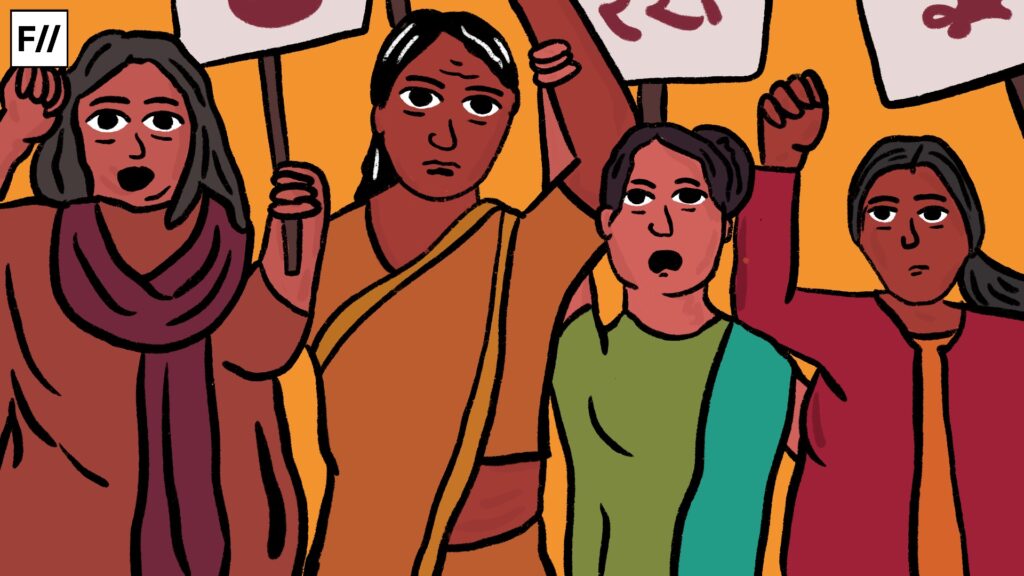A significant portion of the world population is reliant on direct human-nature interactions to sustain their livelihoods. Food production, land use, energy and water conservation, child-rearing and bearing, maintaining hygienic conditions, treatment using medicinal plants and much more are functions predominantly performed by women. Climate change has the greatest impact on individuals who so intimately interact with and are dependent on the ecosphere. These women constitute special knowledge that established and legitimised systems of knowledge creation that can only attain through recognition of alternate systems of knowledge.
The situatedness of knowledge: Where are women from marginalised communities?
Climate change policies are based on the recommendations of climate researchers hailing from top institutions. They are privileged knowledge-creators who enable policy creation that does not account for the needs of marginalised communities. One may mark the increasing representation of women in the United Nations over the years, however, women who play any significant role in international climate negotiations come from privileged backgrounds.
Climate change policies are based on the recommendations of climate researchers hailing from top institutions. They are privileged knowledge-creators who enable policy creation that does not account for the needs of marginalised communities. One may mark the increasing representation of women in the United Nations over the years, however, women who play any significant role in international climate negotiations come from privileged backgrounds.
For instance, women played a significant role in the shaping of the Kyoto Protocol, which was a part of the United Nations Framework Convention on Climate Change (UNFCCC). During the designing of the Kyoto Protocol, the German and the Swiss negotiation leaders were both women. They actively interacted with the ministers of developing countries and recognised the voices of the Global South.

But active participation in policy-making remained marginal for the women in the countries of the Global South, perhaps owing to the countries’ undue dependence on toxic fuels and their inability to incorporate radical policies that can potentially disrupt entire economies. In such a context, gender mainstreaming of climate policy becomes increasingly challenging. However, this is no reason to prevent the introduction of robust policies that is more people-centred.
Major policies in place: The UN
Policies at the nexus of climate change and gender have been slow to emerge. The various issues pertaining to climate and gender codified in international instruments range from “soft” to “hard”. Treaties are the most important instruments with legally-binding articles and details meant to be ratified by countries. Declarations and plans of action are milder instruments that are indicative of what is expected of their signatories, who aren’t held as accountable as they would be in case they violate the terms of an important treaty.
Conventions, on the other hand, are negotiated in more inclusive spaces allowing inputs from various stakeholders as opposed to the state-centric approach of treaties, leading such instruments to have lesser leverage even though they are equal to treaties in terms of their legal weight. Instruments related to the environment and human rights typically fall under the category of “soft” law which reflects their historically inferior status.
In the realm of gender equality, the Convention on the Elimination of All Forms of Discrimination against Women (CEDAW) and the 1995 UN Fourth World Conference on Women in Beijing resulted in the most comprehensive global agreement adopted by the UN.
In the realm of gender equality, the Convention on the Elimination of All Forms of Discrimination against Women (CEDAW) and the 1995 UN Fourth World Conference on Women in Beijing resulted in the most comprehensive global agreement adopted by the UN.

CEDAW is often known as the first “international bill of rights for women”, and addresses several issues related to women’s rights in the realm of climate: “CEDAW obliges parties to take all necessary measures to ensure women benefit from rural development and are involved in all aspects of planning for development. In particular, Article 11 calls for equal employment opportunities including vocational training; Article 14 calls for equal access to agricultural credit and loans, marketing facilities and appropriate technology and equal treatment in land reform and resettlement schemes (CEDAW, 1979). When applied to the climate change agenda these Articles may facilitate adaptation and enhance women’s resilience to impacts of climate change…”
Networks and groups such as ENERGIA and the Women’s Environment & Development Organization (WEDO) have underscored the importance of “boosting women’s participation in decision-making forums, women’s right to own and inherit land, education and capacity-building.” The action plan adopted in Beijing has led to the identification of key sustainable goals and the need for human well-being.
Networks and groups such as ENERGIA and the Women’s Environment & Development Organization (WEDO) have underscored the importance of “boosting women’s participation in decision-making forums, women’s right to own and inherit land, education and capacity-building.” The action plan adopted in Beijing has led to the identification of key sustainable goals and the need for human well-being. Alongside economic agenda, it addressed topics “such as health, sexual and reproductive health and rights (SRHR), action against violence, education, participation and voice, the rights of the girl child, women’s right to land.”
In climate policy, the United Nations Conference on Environment and Development (UNCED) conference or the Earth Summit at Rio de Janeiro in Brazil in 1992 was and remains “the blueprint for international action on the environment.” One of the results of this major event was the document, Agenda 21 and the Rio Declaration which demonstrated the need for gender equality as crucial for the purpose of climate change adaptation and mitigation. For instance, Chapter 24 of Agenda 21, ‘Global Action for Women towards Sustainable and Equitable Development’, recognises areas in which there is an acute need for gender parity to enable the effective implementation of sustainable development goals.

Two of the three major conventions of the conference articulated gender equality principles. These included the UN Convention on Biological Diversity (UNCBD) and the UN Convention to Combat Desertification (UNCCD). The UNCBD reinforced the vital role that women play in the sustainability and conservation of biological diversity. The convention called for genuine participation of women in all levels of policy-making. Similarly, Article 10 of the UNCCD mandated that national action programmes ensure the effective participation of NGOs and local populations – both men and women, especially resource users – at all levels in “policy-planning, decision-making, and implementation”.
Another major document, the UN Framework Convention on Climate Change (UNFCCC) wholly neglected social dimensions at its inception. It has an increasingly troubled history in terms of inclusion and representation of women in policy-making bodies. (reference). It only underwent a major shift in 2009 when the input of civil society, apart from already-existing participation from business and environmental organisations, became important. Women’s civil society groups were formally recognised as a constituency (one of the nine groups considered to be stakeholders in the convention) and the Women and Gender Constituency (WGC) was established.
Historically, the UN has been criticised for its male-dominated institutions and general indecision pertaining to anything significant. In a more recent publication by the UN Women, the inclusion of gender at the participation and implementation level in the UNFCCC has considerably increased and some serious steps have been taken to mainstream gender in decision-making and policies.
Historically, the UN has been criticised for its male-dominated institutions and general indecision pertaining to anything significant. In a more recent publication by the UN Women, the inclusion of gender at the participation and implementation level in the UNFCCC has considerably increased and some serious steps have been taken to mainstream gender in decision-making and policies. However, Joane Nagel points out the very improvement in terms of representation, that “The women had been called in, but clearly they had not yet arrived in substantially increased numbers. Women’s representation on COP delegations a year after Doha at COP19 in Poznań in 2013 (29 percent) was virtually the same as their presence a decade earlier at COP9 in Milan in 2003 (28 percent).”
However, pressure from women’s rights groups only led to lip service in the first decade of the 21st century. For instance, the Indonesian government expressed its commitment to mainstream gender in COP13 at Bali, which they conveniently forgot about the next COP in Poland in 2008. In a similar vein, the then-secretary-general of the UN, Ban Ki-moon, expressed the need for the inclusion of women in policy-making in the run-up to COP15 to be held in Copenhagen. However, in 2010, he went on to appoint an only-male committee on Climate Change Financing which enraged women’s groups.
Climate change policies and intersectionality
Research on gender-inclusivity and representation in the dialogue surrounding climate change have increased substantially, however, there is a paucity of literature on the complex issues experienced by women all across the globe owing to their different social and economic positions. Studies on gender and climate change that highlight any single variable (gender, class, or geographical location) as playing a predominant role are important, but research that demonstrates increased vulnerability owing to an overlap of multiple structures of domination is meagre. A top-down approach where climate policies are rolled out to challenge existing power relations will have unintended positive and negative effects on marginalised groups.
For instance, phasing out fossil fuels and coercing industries to invest in renewable energy and bioenergy certainly challenges existing power relations. Exploiting bioenergy involves alterations in biodiversity. Thus, how such moves multiply the effects on marginalised communities dependent on nature for their livelihood requires thorough consideration. Without such considerations, inequities are bound to exacerbate.
Note: The policies and instruments delineated below are in no way representative of the breadth of UN agreements that exist on the topic. That would require a book-length study. What follows is a broad overview.
About the author(s)
Shakti (she/her) is an English major and an aspiring tea sommelier. She loves reading poetry and drama and can be found with a Kindle most time. She intends to become a teacher of humanities and is passionate about literature, films, politics, and history. In her free time, she has been caught watching cringe content, however, she fervently denies these claims.





